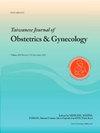Concomitant omphalocele, craniorachischisis and ectopic cordis associated with trisomy 18 diagnosed in first trimester
IF 2
4区 医学
Q2 OBSTETRICS & GYNECOLOGY
引用次数: 0
Abstract
Objective
We present a rare case of trisomy 18 of maternal origin in a pregnancy with omphalocele, craniorachischisis, and ectopia cordis.
Case report
A 38-year-old woman, G3P1A1, was diagnosed with fetal anencephaly, an extrathoracic heart (ectopic cordis), deformity of spine and a stomach-and-intestine-containing omphalocele by prenatal ultrasound at 12 weeks of gestation. The patient's husband was 39 years old and healthy. The patient had no significant past medical history. She was a nonsmoker, with a pre-pregnancy BMI of 23.7 and was not diabetic. There was no family history of malformations, diseases, or teratogenic medication. The patient had not received assisted reproductive technology during this pregnancy. The pregnancy was terminated in the 13th gestational week. Additional anomalies detected after termination of the pregnancy included small and triangular face, abnormal posturing of hands, clubfoot and craniorachischisis. Crown-heel length was 5.5 cm consistent with a 12–13-week gestational age. Postnatal cytogenetic analysis of chorionic villi obtained by placental sampling revealed a karyotype of 47, XX + 18. Polymorphic DNA marker analysis by quantitative fluorescent polymerase chain reaction (QF-PCR) assays showed a maternal origin of the extra chromosome 18.
Conclusion
The concomitant omphalocele, ectopia cordis and craniorachischisis may be related to trisomy 18. Genetic analysis of the postmortem tissue and the analysis of the parental origin of the extra chromosome 18 using QF-PCR, provide valuable information for genetic counseling.
在妊娠早期诊断的18三体伴发脐膨出、颅裂和异位心脏科
目的报告一例罕见的18三体母源性妊娠伴脐膨出、颅裂和心异位的病例。病例报告一名38岁妇女,G3P1A1,在妊娠12周时通过产前超声诊断为胎儿无脑畸形,胸外心脏(异位心),脊柱畸形和含胃肠道的脐膨出。病人的丈夫39岁,身体健康。患者无明显的既往病史。她不吸烟,孕前BMI为23.7,也没有糖尿病。没有畸形、疾病或致畸药物家族史。患者在怀孕期间未接受辅助生殖技术。妊娠第13周终止妊娠。终止妊娠后发现的其他异常包括小而三角形的脸,异常的手姿势,内翻足和颅骨裂。冠跟长度为5.5厘米与胎龄12 - 13周相符。胎盘取样获得的绒毛膜绒毛的出生后细胞遗传学分析显示核型为47,xx + 18。定量荧光聚合酶链反应(QF-PCR)的多态DNA标记分析表明,多余的18号染色体来自母亲。结论伴有脐膨出、心外异位、颅骨裂可能与18三体有关。利用QF-PCR对死后组织进行遗传分析,并分析多出的18号染色体亲本来源,为遗传咨询提供有价值的信息。
本文章由计算机程序翻译,如有差异,请以英文原文为准。
求助全文
约1分钟内获得全文
求助全文
来源期刊

Taiwanese Journal of Obstetrics & Gynecology
OBSTETRICS & GYNECOLOGY-
CiteScore
3.60
自引率
23.80%
发文量
207
审稿时长
4-8 weeks
期刊介绍:
Taiwanese Journal of Obstetrics and Gynecology is a peer-reviewed journal and open access publishing editorials, reviews, original articles, short communications, case reports, research letters, correspondence and letters to the editor in the field of obstetrics and gynecology.
The aims of the journal are to:
1.Publish cutting-edge, innovative and topical research that addresses screening, diagnosis, management and care in women''s health
2.Deliver evidence-based information
3.Promote the sharing of clinical experience
4.Address women-related health promotion
The journal provides comprehensive coverage of topics in obstetrics & gynecology and women''s health including maternal-fetal medicine, reproductive endocrinology/infertility, and gynecologic oncology. Taiwan Association of Obstetrics and Gynecology.
 求助内容:
求助内容: 应助结果提醒方式:
应助结果提醒方式:


